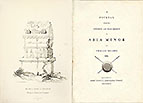There are no books on the history of Indian architecture dealing with the relationship between Indian chaitya caves and Lycian cave tombs. James Fergusson is apt to be regarded as a specialist of history of Indian architecture, but it was the history of global architecture that he intended to thoroughly complete. So his main work "A History of Architecture in All Countries" (1865) naturally treats Lycian architecture too. As the relevant part was entirely reproduced from his former book "The Illustrated Handbook of Architecture" (1855), it was written in not long after the discovery of Lycian remains. In this book, Fergusson reproduced the illustrations from "An Account of Discoveries in Lycia" (1841) by Charles Fellows, and other books of Texier or Forbes. He had further inspected the "Tomb of Payava" and other remains in the Lycian room of the British Museum. Based on this knowledge, Fergusson wrote in the chapter of Lycian Architecture in "The Illustrated Handbook of Architecture" that 'the form and construction of the older Buddhist temples resemble so singularly these examples in Lycia'. However, he did not state anything about Lycian architecture in the chapter of Buddhist caves in his later book "History of Indian and Eastern Architecture" (1876), which was an amplified book based on the Indian part of his former "A History of Architecture in All Countries". In 1880, he published another book in collaboration with James Burgess "The Cave Temples of India", in which the Lycian rock cave appears only in a footnote regarding the form of the upper part of the Bhima Rata at Mahabalipuram, but still he had not reached the idea of Lycian influence on Indian architecture. This would be the reason why no architectural historians afterwards seem to have pursued the relationship between Lycia and India. As Fergusson first systematized the history of Indian architecture, influencing scholars and students widely and strongly, every historian of Indian art and architecture consults his book at least once. But it is not "A History of Architecture in All Countries" but the "History of Indian and Eastern Architecture" that they consult, so they do not get the knowledge about Lycian architecture. Even if taking "The Cave Temples of India", they would not come to suspect the Lycian influence from only the footnote, with one figure, on Mahabalipuram. As for Fletcher's "A History of Architecture" which has been widely read, there is no indication about Lycian sarcophagi and cave tombs at all. Actually, it was not Fergusson but a drawing of the Tomb of Payava in the British Museum that made me notice the relationship between Lycian architecture and Indian cave temples for the first time. It was by the 19th century French architect Viollet-Le-Duc, an expert in Gothique architecture and its restoration. In my journey in France to see Romanesque architecture a long time ago, I purchased a reprint edition of Viollet-Le-Duc's "Entretiens sur l'Architecture" (1863), in which the drawing appears as the first of its plates. Having looked at it many times, I did not notice anything special until I became bothered by the riddle about the form of Indian Chaitya caves. I happened to look at it again with great surprise and wondered if it was a drawing of a Buddhist Chaitya cave in India.
 The sarcophagus of Payava drawn by Viollet-le-Duc Immediately after finding it was a Lycian sarcophagus, I started researching the relationship between Lycian and Indian architecture. I checked the books of Fergusson again, as mentioned above; there is a description about Lycian architecture in his "A History of Architecture in All Countries". Then why did he not find the influential relationship there? Since he regarded Gandharan Art as influenced by Roman art after the Common Era, rather than the Grecian art of B.C.E., he might have had no idea that Lycian architecture in the 4th century B.C.E. had influenced Indian architecture. Besides, he did not visit Lycia at all, so he could not examine it in detail. I checked whether there were any other resources concerning the relationship between India and Lycia, finding only one book entitled "L'Inde et l'Orient Classique" (1937) written by Gisbert Combaz. This book does not belong to architectural history, but it includes an article on the relationship between Indian and ancient Middle Eastern styles of design by showing hand-written sketches, and comprehensively listing related aspects concerning formative arts. He suggests that there might be an influential relationship between Anatolian caves and sarcophagi, including Lycian, and Indian cave temples.

|
